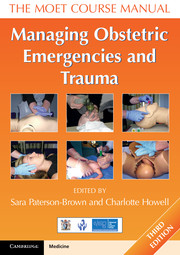Book contents
- Frontmatter
- Dedication
- Contents
- Working Group
- About the authors
- Acknowledgements
- Abbreviations
- Section 1 Introduction
- Section 2 Recognition
- Section 3 Resuscitation
- Section 4 Trauma
- Section 5 Other medical and surgical emergencies
- Section 6 Obstetric emergencies
- 24 Pre-eclampsia and eclampsia
- 25 Major obstetric haemorrhage
- 26 Caesarean section
- 27 Placenta accreta and retained placenta
- 28 Uterine inversion
- 29 Ruptured uterus
- 30 Ventouse and forceps delivery
- 31 Shoulder dystocia
- 32 Umbilical cord prolapse
- 33 Face presentation
- 34 Breech delivery and external cephalic version
- 35 Twin pregnancy
- 36 Complex perineal and anal sphincter trauma
- 37 Symphysiotomy and destructive procedures
- 38 Anaesthetic complications in obstetrics
- Section 7 Triage and transfer
- Section 8 Human issues
- Index
37 - Symphysiotomy and destructive procedures
- Frontmatter
- Dedication
- Contents
- Working Group
- About the authors
- Acknowledgements
- Abbreviations
- Section 1 Introduction
- Section 2 Recognition
- Section 3 Resuscitation
- Section 4 Trauma
- Section 5 Other medical and surgical emergencies
- Section 6 Obstetric emergencies
- 24 Pre-eclampsia and eclampsia
- 25 Major obstetric haemorrhage
- 26 Caesarean section
- 27 Placenta accreta and retained placenta
- 28 Uterine inversion
- 29 Ruptured uterus
- 30 Ventouse and forceps delivery
- 31 Shoulder dystocia
- 32 Umbilical cord prolapse
- 33 Face presentation
- 34 Breech delivery and external cephalic version
- 35 Twin pregnancy
- 36 Complex perineal and anal sphincter trauma
- 37 Symphysiotomy and destructive procedures
- 38 Anaesthetic complications in obstetrics
- Section 7 Triage and transfer
- Section 8 Human issues
- Index
Summary
Objectives
On successfully completing this topic, you will be able to:
discuss the indications for symphysiotomy
understand the technique
understand the role of destructive operations
understand the procedures involved in destructive operations.
Introduction
Symphysiotomy
Symphysiotomy is a relatively common procedure in the developing world, where it is used in situations of cephalopelvic disproportion when CS is not available. Symphysiotomy leaves no uterine scar and subsequent risk of ruptured uterus in future labours is not increased. Van Roosmalen illustrated the potential morbidity and mortality of caesarean sections carried out in developing country rural hospitals. Mortalities of up to 5% and an incidence of uterine scar rupture in subsequent pregnancies of up to 6.8% have been reported. Symphysiotomy has a low maternal mortality, with three deaths reported in a series of 1752 symphysiotomies. All three deaths were unrelated to the procedure.
Hartfield reviewed the cases of 138 women in whom symphysiotomy had been per formed. Early and late complications were few and rarely serious, if recommended guidelines were followed. He also reviewed published series of women followed up, for two years or more, after symphysiotomy and concluded that permanent major orthopaedic disability only occurs in 1–2% of cases.
Pape carried out a prospective review of 27 symphysiotomies performed between 1992 and 1994. Five women had paraurethral tears needing suturing, nine had oedema of the vulva or haematomas tracking from the symphysiotomy. All made a full recovery and severe pelvic pain was not a feature in any woman.
- Type
- Chapter
- Information
- Managing Obstetric Emergencies and TraumaThe MOET Course Manual, pp. 429 - 436Publisher: Cambridge University PressPrint publication year: 2014



